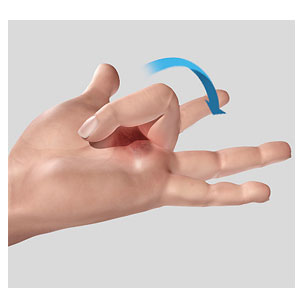What is Trigger Finger?
The ability to bend or flex fingers is controlled by tendons, which connect muscles to the bones of the fingers. The tendons in fingers run along the length of the bone and are kept in place at intervals by tunnels of ligaments called pulleys. When the fingers bend, or are straightened, a slippery coating called tenosynovium helps the tendons smoothly glide through the ligaments with reduced friction.

Inflammation in the tenosynovium leads to a condition called trigger finger, where one of the fingers or thumb is caught in a bent position. The affected finger may straighten with a quick snap, similar to pulling and releasing the trigger on a gun, hence the name trigger finger.
Causes of Trigger Finger
Trigger finger is caused by inflammation of the tissues around the tendon. The inflammation can form a nodule, making it difficult for the tendon to glide smoothly within its tunnel (or sheath). It causes “catching” of the finger in a bent position and then suddenly releases the finger straight.
Some medical conditions can contribute to trigger finger, such as:
- Diabetes
- Rheumatoid arthritis
- Hypothyroidism
- Amyloidosis
- Sarcoidosis
Trigger finger syndrome can also be attributed to repetitive motion. Individuals who perform heavy, repetitive hand and wrist movements with prolonged gripping at work could play a role. Alternatively, trigger finger may also be idiopathic, or arise with no known underlying cause.
Signs and Symptoms of Trigger Finger
Commonly reported symptoms associated with trigger finger include the following:
- Pain and tenderness over the inflamed tendon nodule
- Bent finger suddenly pops out and straightens
- “Popping” or “clicking” sound or sensation when the nodule moves through the pulley
- Finger feels stiff and sore
- Finger may get locked with the inability to straighten when the nodule grows large and gets stuck in the pulley
- Symptoms are worse in the morning
Long-term complications of untreated trigger finger can include permanent digit swelling and contracture.
Treatment for Trigger Finger
Your surgeon will recommend conservative treatment options to treat trigger finger symptoms. Treatment options will vary depending on the severity of the condition.
Conservative treatment options may include the following:
- Treating any underlying medical conditions that may be causing the problem, such as diabetes
- Splinting or taping
- Occupational therapy may be recommended for massage, heat, ice and exercises to improve the finger.
- Ice over the affected finger may help symptoms. Apply ice over a towel for 5-15 min, 3-4x daily.
- Non-steroidal anti-inflammatory drugs (NSAIDs) may help to relieve pain and inflammation.
- Steroid injections into the affected finger may help reduce the inflammation
Trigger Finger Release Surgery.
Sometimes conservative treatment can fail to resolve the condition. If symptoms persist and your quality of life is adversely affected, your surgeon may recommend you undergo a surgical procedure to release the pulley and allow the tendon to glide without triggering.
The surgery involves a small incision in the palm/finger area. The surgeon then releases part of the pulley (tunnel) the tendon glides in to make more room for the tendon. This allows the tendon to glide without triggering. This procedure is frequently done with minimally invasive techniques under local only anesthesia. Your surgeon will decide which options are best for you based on your preference and medical conditions.
